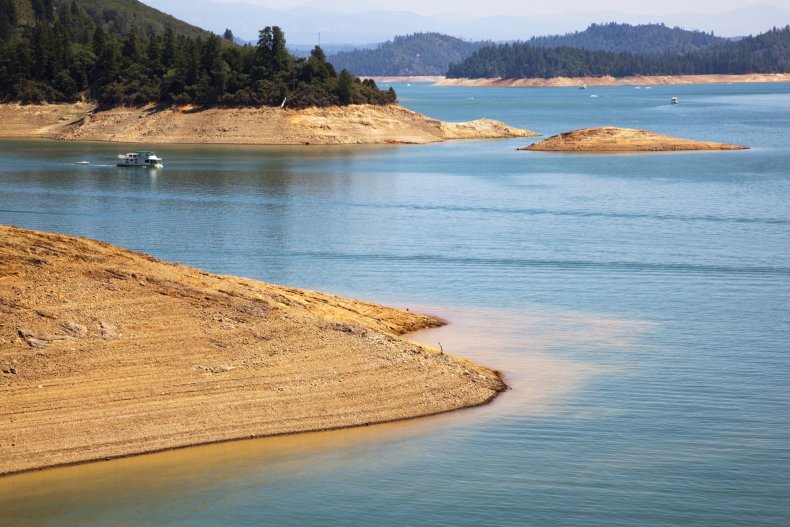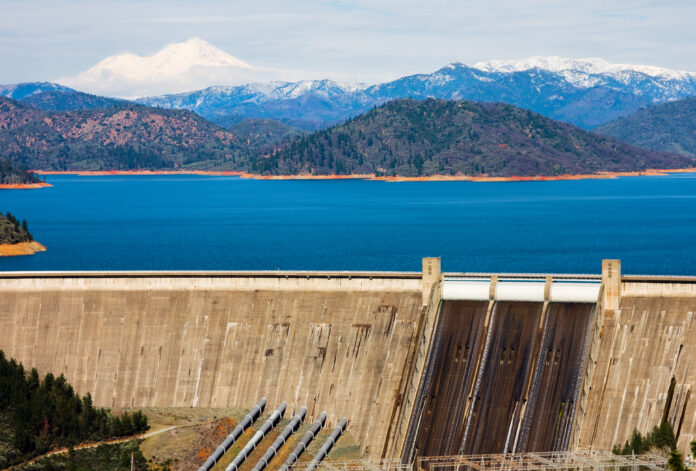Because of heavy rainfall throughout northern California over the previous few days, Lake Shasta’s water stage is now greater than it has been in years.
As of Might 9, the lake is at 1,063.77 ft above water stage, having risen almost 150 ft because the begin of 2023, when it stood at 928.01 ft.
These water ranges are greater than they’ve been since 2019—each right now of yr and at any level—and presently stand slightly below the 2019 excessive of 1,064.5 ft. The lake’s present ranges are subsequently solely simply 3.2 ft shy of its 1,067-foot capability.
ISTOCK / GETTY IMAGES PLUS
“Shasta’s going to remain fairly full all summer time lengthy,” Don Bader, the Northern California Space Supervisor for the Bureau of Reclamation, instructed Redding information station KRCR. “We’ll go down about 40 ft—40 to 50 ft by the tip of September, which the boaters; the marine operators are thrilled as a result of it’ll be nice recreation on the lake.
“After which going into subsequent winter, assuming we get simply the conventional winter storms, we’ll be pumped full subsequent spring at Shasta, which is nice for subsequent yr. So, we already know going into subsequent yr we’re completely trending in the precise course right here out of three years of drought,”
Lake Shasta, situated in Shasta County, California, is the most important reservoir within the state. Its elevated water ranges are due largely to the heavy rainfall that battered the state in the course of the early spring, refilling lots of the dried-up reservoirs. On Might 9 final yr, Lake Shasta solely stood at 946.67 ft.
“Statewide the reservoirs are typically in fine condition with most at or above their historic averages and a few reservoirs having to let important water go to take care of area for floods,” Jeff Mount, a senior fellow on the Public Coverage Institute of California’s Water Coverage Middle, beforehand instructed Newsweek.
The a number of highly effective atmospheric river storms that hit California this yr additionally served to bury the Sierra Nevadas in snowfall, bulking up the snowpack within the mountains to report ranges. Because the spring temperatures improve, this snow is because of begin melting, flowing down the mountains into the valleys and refilling the reservoirs additional as a part of the “large soften.”
“Snowpack offers 30 % of California’s freshwater and performs a important function within the replenishment of reservoir ranges when it melts and will increase streamflows within the spring and early summer time,” Andrew Schwartz, lead scientist and supervisor on the UC Berkeley Central Sierra Snow Laboratory, instructed Newsweek in February. “It acts as its personal storage system on high of the mountains.”
This soften could, subsequently, additional improve the water ranges in Lake Shasta.

ISTOCK / GETTY IMAGES PLUS
Nevertheless, the soften has additionally led to flooding within the Central Valley, Lake Tulare, and in Yosemite, and is feared to trigger extra within the San Joaquin River Basin. Because of the ongoing megadrought plaguing the U.S. West, the soil has grow to be so parched that if the water all runs down directly, it could run over the soil as a substitute of soaking in, inflicting flash flooding.
Whereas extra water looks as if it might be good to raise the state out of drought, the dry soils and flash flooding imply that the depleted but important groundwater provides will not be being replenished.
“It is going to take a number of years of above-normal precipitation—each rain and snow throughout the suitable instances of the yr,” Lara Fowler, an environmental and power points lawyer and interim director of the Penn State Sustainability Institute at Penn State College, beforehand instructed Newsweek.
“As soil moisture and floor water provides have grow to be depleted, increasingly more groundwater pumping has additionally led to a decline in aquifer ranges in lots of locations. Such groundwater contributes to baseflows in streams,” she mentioned. “So not solely would floor water (streams and rivers) have to refill, so does soil moisture and groundwater ranges, the final of which will be very sluggish to recharge.”
Do you have got a tip on a science story that Newsweek needs to be protecting? Do you have got a query about Laka Shasta? Tell us by way of [email protected].


